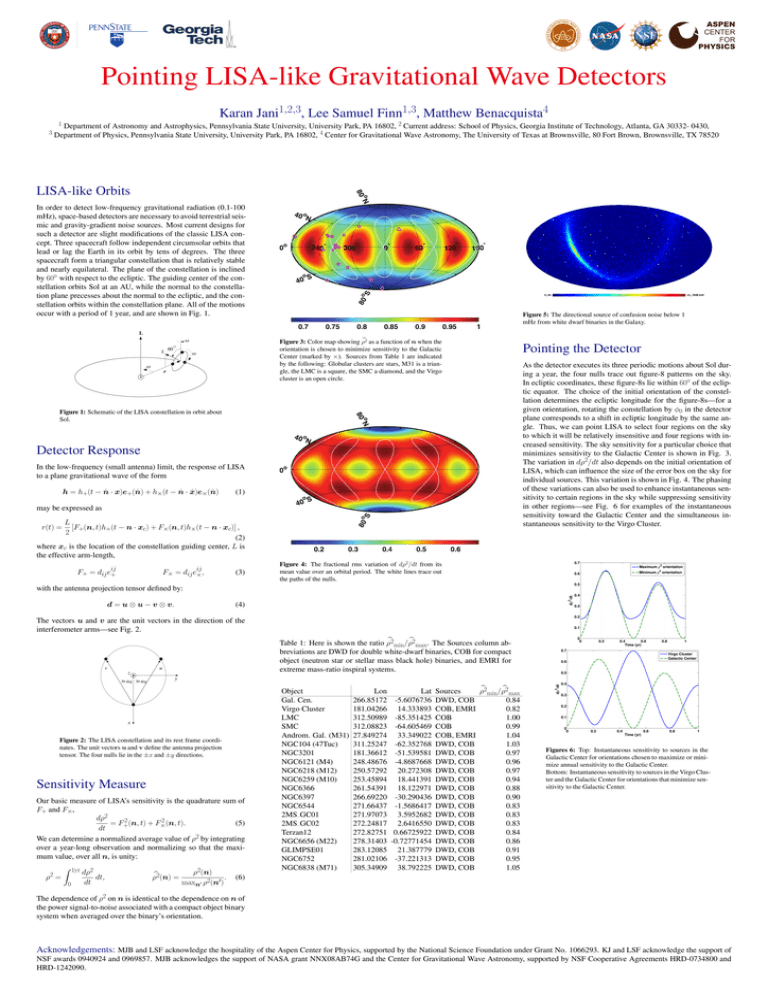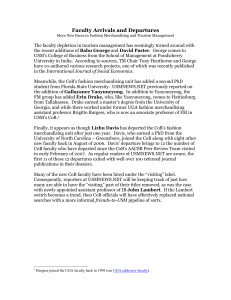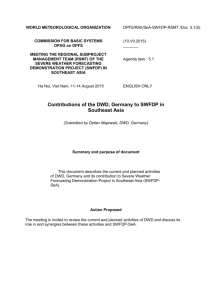Document 10441612
advertisement

Pointing LISA-like Gravitational Wave Detectors Karan 1,2,3 Jani , Lee Samuel 1,3 Finn , Matthew 4 Benacquista 1 Department of Astronomy and Astrophysics, Pennsylvania State University, University Park, PA 16802, 2 Current address: School of Physics, Georgia Institute of Technology, Atlanta, GA 30332- 0430, 3 Department of Physics, Pennsylvania State University, University Park, PA 16802, 4 Center for Gravitational Wave Astronomy, The University of Texas at Brownsville, 80 Fort Brown, Brownsville, TX 78520 LISA-like Orbits In order to detect low-frequency gravitational radiation (0.1-100 mHz), space-based detectors are necessary to avoid terrestrial seismic and gravity-gradient noise sources. Most current designs for such a detector are slight modifications of the classic LISA concept. Three spacecraft follow independent circumsolar orbits that lead or lag the Earth in its orbit by tens of degrees. The three spacecraft form a triangular constellation that is relatively stable and nearly equilateral. The plane of the constellation is inclined by 60◦ with respect to the ecliptic. The guiding center of the constellation orbits Sol at an AU, while the normal to the constellation plane precesses about the normal to the ecliptic, and the constellation orbits within the constellation plane. All of the motions occur with a period of 1 year, and are shown in Fig. 1. Figure 5: The directional source of confusion noise below 1 mHz from white dwarf binaries in the Galaxy. L ω ○ z 60 Figure 3: Color map showing ρb2 as a function of n when the orientation is chosen to minimize sensitivity to the Galactic Center (marked by ×). Sources from Table 1 are indicated by the following: Globular clusters are stars, M31 is a triangle, the LMC is a square, the SMC a diamond, and the Virgo cluster is an open circle. ω ω r Figure 1: Schematic of the LISA constellation in orbit about Sol. Detector Response In the low-frequency (small antenna) limit, the response of LISA to a plane gravitational wave of the form h = h+(t − n̂ · x)e+(n̂) + h×(t − n̂ · x̂)e×(n̂) (1) may be expressed as L r(t) = [F+(n, t)h+(t − n · xc) + F×(n, t)h×(t − n · xc)] , 2 (2) where xc is the location of the constellation guiding center, L is the effective arm-length, ij ij F+ = dij e+ F× = dij e× , (3) Pointing the Detector As the detector executes its three periodic motions about Sol during a year, the four nulls trace out figure-8 patterns on the sky. In ecliptic coordinates, these figure-8s lie within 60◦ of the ecliptic equator. The choice of the initial orientation of the constellation determines the ecliptic longitude for the figure-8s—for a given orientation, rotating the constellation by φ0 in the detector plane corresponds to a shift in ecliptic longitude by the same angle. Thus, we can point LISA to select four regions on the sky to which it will be relatively insensitive and four regions with increased sensitivity. The sky sensitivity for a particular choice that minimizes sensitivity to the Galactic Center is shown in Fig. 3. The variation in dρ2/dt also depends on the initial orientation of LISA, which can influence the size of the error box on the sky for individual sources. This variation is shown in Fig. 4. The phasing of these variations can also be used to enhance instantaneous sensitivity to certain regions in the sky while suppressing sensitivity in other regions—see Fig. 6 for examples of the instantaneous sensitivity toward the Galactic Center and the simultaneous instantaneous sensitivity to the Virgo Cluster. Figure 4: The fractional rms variation of dρ2/dt from its mean value over an orbital period. The white lines trace out the paths of the nulls. 0.7 0.5 dρ2/dt (4) z 0 0 0.2 0.4 0.6 Time (yr) 0.8 1 0.7 Virgo Cluster Galactic Center 0.6 0.5 y x Figure 2: The LISA constellation and its rest frame coordinates. The unit vectors u and v define the antenna projection tensor. The four nulls lie in the ±x and ±y directions. Sensitivity Measure Our basic measure of LISA’s sensitivity is the quadrature sum of F+ and F×, dρ2 2 (n, t). = F+2 (n, t) + F× (5) dt We can determine a normalized average value of ρ2 by integrating over a year-long observation and normalizing so that the maximum value, over all n, is unity: Z 1yr 2 2(n) dρ ρ ρ2 = dt, ρb2(n) = . (6) 2 0 dt maxn0 ρ (n ) 0 Object Gal. Cen. Virgo Cluster LMC SMC Androm. Gal. (M31) NGC104 (47Tuc) NGC3201 NGC6121 (M4) NGC6218 (M12) NGC6259 (M10) NGC6366 NGC6397 NGC6544 2MS GC01 2MS GC02 Terzan12 NGC6656 (M22) GLIMPSE01 NGC6752 NGC6838 (M71) Lon 266.85172 181.04266 312.50989 312.08823 27.849274 311.25247 181.36612 248.48676 250.57292 253.45894 261.54391 266.69220 271.66437 271.97073 272.24817 272.82751 278.31403 283.12085 281.02106 305.34909 Lat -5.6076736 14.333893 -85.351425 -64.605469 33.349022 -62.352768 -51.539581 -4.8687668 20.272308 18.441391 18.122971 -30.290436 -1.5686417 3.5952682 2.6416550 0.66725922 -0.72771454 21.387779 -37.221313 38.792225 ρb2min/ρb2max Sources DWD, COB 0.84 COB, EMRI 0.82 COB 1.00 COB 0.99 COB, EMRI 1.04 DWD, COB 1.03 DWD, COB 0.97 DWD, COB 0.96 DWD, COB 0.97 DWD, COB 0.94 DWD, COB 0.88 DWD, COB 0.90 DWD, COB 0.83 DWD, COB 0.83 DWD, COB 0.83 DWD, COB 0.84 DWD, COB 0.86 DWD, COB 0.91 DWD, COB 0.95 DWD, COB 1.05 dρ2/dt 30 deg 30 deg 0.3 0.1 Table 1: Here is shown the ratio ρb2min/ρb2max. The Sources column abbreviations are DWD for double white-dwarf binaries, COB for compact object (neutron star or stellar mass black hole) binaries, and EMRI for extreme mass-ratio inspiral systems. u 0.4 0.2 The vectors u and v are the unit vectors in the direction of the interferometer arms—see Fig. 2. v Minimum ρ2 orientation 0.6 with the antenna projection tensor defined by: d = u ⊗ u − v ⊗ v. Maximum ρ2 orientation 0.4 0.3 0.2 0.1 0 0 0.2 0.4 0.6 0.8 1 Time (yr) Figures 6: Top: Instantaneous sensitivity to sources in the Galactic Center for orientations chosen to maximize or minimize annual sensitivity to the Galactic Center. Bottom: Instantaneous sensitivity to sources in the Virgo Cluster and the Galactic Center for orientations that minimize sensitivity to the Galactic Center. The dependence of ρ2 on n is identical to the dependence on n of the power signal-to-noise associated with a compact object binary system when averaged over the binary’s orientation. Acknowledgements: MJB and LSF acknowledge the hospitality of the Aspen Center for Physics, supported by the National Science Foundation under Grant No. 1066293. KJ and LSF acknowledge the support of NSF awards 0940924 and 0969857. MJB acknowledges the support of NASA grant NNX08AB74G and the Center for Gravitational Wave Astronomy, supported by NSF Cooperative Agreements HRD-0734800 and HRD-1242090.





